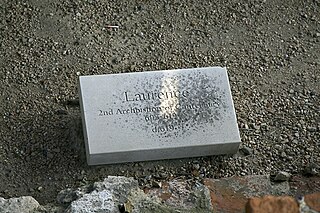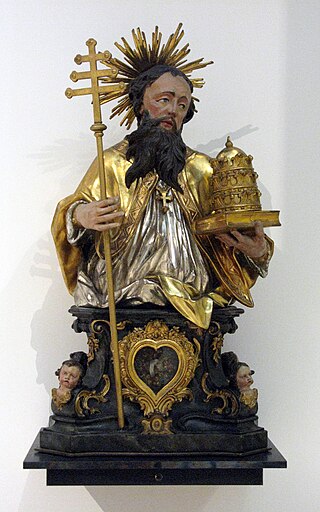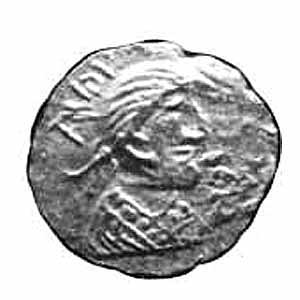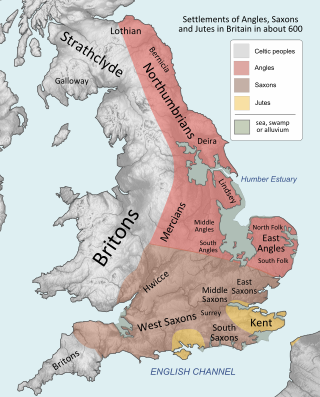
Justus was the fourth Archbishop of Canterbury. Pope Gregory the Great, sent Justus from Italy to England on a mission to Christianize the Anglo-Saxons from their native paganism, probably arriving with the second group of missionaries despatched in 601. Justus became the first Bishop of Rochester in 604 and attended a church council in Paris in 614.

Laurence was the second Archbishop of Canterbury, serving from about 604 to 619. He was a member of the Gregorian mission sent from Italy to England to Christianise the Anglo-Saxons from their native Anglo-Saxon paganism, although the date of his arrival is disputed. He was consecrated archbishop by his predecessor, Augustine of Canterbury, during Augustine's lifetime, to ensure continuity in the office. While archbishop, he attempted unsuccessfully to resolve differences with the native British bishops by corresponding with them about points of dispute. Laurence faced a crisis following the death of King Æthelberht of Kent, when the king's successor abandoned Christianity; he eventually reconverted. Laurence was revered as a saint after his death in 619.
Mellitus was the first bishop of London in the Saxon period, the third Archbishop of Canterbury, and a member of the Gregorian mission sent to England to convert the Anglo-Saxons from their native paganism to Christianity. He arrived in 601 AD with a group of clergy sent to augment the mission, and was consecrated as Bishop of London in 604. Mellitus was the recipient of a famous letter from Pope Gregory I known as the Epistola ad Mellitum, preserved in a later work by the medieval chronicler Bede, which suggested the conversion of the Anglo-Saxons be undertaken gradually, integrating pagan rituals and customs. In 610, Mellitus returned to Italy to attend a council of bishops, and returned to England bearing papal letters to some of the missionaries.

Pope Linus was the bishop of Rome from c. AD 67 to his death. He is generally regarded as the second Bishop of Rome, after St. Peter. As with all the early popes, he was canonized.

Pope Honorius I was the bishop of Rome from 27 October 625 to his death. He was active in spreading Christianity among Anglo-Saxons and attempted to convince the Celts to calculate Easter in the Roman fashion. He is chiefly remembered for his correspondence with Patriarch Sergius I of Constantinople over the latter's monothelite teachings. Honorius was posthumously anathematized, initially for subscribing to monothelitism, and later only for failing to end it. The anathema against Honorius I became one of the central arguments against the doctrine of papal infallibility.

Pope Boniface I was the bishop of Rome from 28 December 418 to his death on 4 September 422. His election was disputed by the supporters of Eulalius until the dispute was settled by Emperor Honorius. Boniface was active in maintaining church discipline, and he restored certain privileges to the metropolitical sees of Narbonne and Vienne, exempting them from any subjection to the primacy of Arles. He was a contemporary of Augustine of Hippo, who dedicated to him some of his works.
Pope Boniface IV, OSB was the bishop of Rome from 608 to his death. Boniface had served as a deacon under Pope Gregory I, and like his mentor, he ran the Lateran Palace as a monastery. As pope, he encouraged monasticism. With imperial permission, he converted the Pantheon into a church. In 610, he conferred with Bishop Mellitus of London regarding the needs of the English Church. He is venerated as a saint in the Catholic Church with a universal feast day on 8 May.

Pope Siricius was the bishop of Rome from December 384 to his death. In response to inquiries from Bishop Himerius of Tarragona, Siricius issued the Directa decretal, containing decrees of baptism, church discipline and other matters. His are the oldest completely preserved papal decretals. He is sometimes said to have been the first bishop of Rome to call himself pope.

Pope Zachary was the bishop of Rome from 28 November 741 to his death. He was the last pope of the Byzantine Papacy. Zachary built the original church of Santa Maria sopra Minerva, forbade the traffic of slaves in Rome, negotiated peace with the Lombards, and sanctioned Pepin the Short's usurpation of the Frankish throne from Childeric III. Zachary is regarded as a capable administrator and a skillful and subtle diplomat in a dangerous time.

Pope Eleutherius, also known as Eleutherus, was the bishop of Rome from c. 174 to his death. His pontificate is alternatively dated to 171-185 or 177-193. He is venerated as a saint in the Catholic Church.

Pope Adeodatus I, also called Deodatus I or Deusdedit, was the bishop of Rome from 19 October 615 to his death. He was the first priest to be elected pope since John II in 533. The first use of lead seals or bullae on papal documents is attributed to him. His feast day is 8 November.
Pope Vigilius was the bishop of Rome from 29 March 537 to his death. He is considered the first pope of the Byzantine papacy. Born into Roman aristocracy, Vigilius served as a deacon and papal apocrisiarius in Constantinople. He allied with Empress Theodora, who sought his help to establish Monophysitism, and was made pope after the deposition of Silverius. After he refused to sign Emperor Justinian I's edict condemning the Three Chapters, Vigilius was arrested in 545 and taken to Constantinople. He died in Sicily while returning to Rome.
Paulinus was a Roman missionary and the first Bishop of York. A member of the Gregorian mission sent in 601 by Pope Gregory I to Christianize the Anglo-Saxons from their native Anglo-Saxon paganism, Paulinus arrived in England by 604 with the second missionary group. Little is known of Paulinus's activities in the following two decades.

Eadbald was King of Kent from 616 until his death in 640. He was the son of King Æthelberht and his wife Bertha, a daughter of the Merovingian king Charibert. Æthelberht made Kent the dominant force in England during his reign and became the first Anglo-Saxon king to convert to Christianity from Anglo-Saxon paganism. Eadbald's accession was a significant setback for the growth of the church, since he retained his people's paganism and did not convert to Christianity for at least a year, and perhaps for as much as eight years. He was ultimately converted by either Laurentius or Justus, and separated from his first wife, who had been his stepmother, at the insistence of the church. Eadbald's second wife was Emma, who may have been a Frankish princess. They had two sons, Eormenred and Eorcenberht, and a daughter, Eanswith.
Pope John VI was the bishop of Rome from 30 October 701 to his death. John VI was a Greek from Ephesus who reigned during the Byzantine Papacy. His papacy was noted for military and political breakthroughs on the Italian Peninsula. He was succeeded by Pope John VII after a vacancy of less than two months. The body of the pope was buried in Old St. Peter's Basilica.
Pope Adeodatus II, sometimes called Deodatus, was the bishop of Rome from 672 to his death. He devoted much of his papacy to improving churches and fighting monothelitism.
Pope Donus was the bishop of Rome from 676 to his death. Few details survive about him or his achievements beyond what is recorded in the Liber Pontificalis.
Dioscorus was a deacon of the Alexandrian and the Roman church from 506. In a disputed election following the death of Pope Felix IV, the majority of electors picked him to be pope, in spite of Pope Felix's wishes that Boniface II should succeed him. However, Dioscorus died less than a month after the election, allowing Boniface to be consecrated pope and Dioscorus to be branded an antipope.

The Gregorian mission or Augustinian mission was a Christian mission sent by Pope Gregory the Great in 596 to convert Britain's Anglo-Saxons. The mission was headed by Augustine of Canterbury. By the time of the death of the last missionary in 653, the mission had established Christianity among the southern Anglo-Saxons. Along with the Irish and Frankish missions it converted Anglo-Saxons in other parts of Britain as well and influenced the Hiberno-Scottish missions to continental Europe.
The Christianisation of Anglo-Saxon England was a process spanning the 7th century. It was essentially the result of the Gregorian mission of 597, which was joined by the efforts of the Hiberno-Scottish mission from the 630s. From the 8th century, the Anglo-Saxon mission was, in turn, instrumental in the conversion of the population of the Frankish Empire.
 Herbermann, Charles, ed. (1913). "Pope Honorius I". Catholic Encyclopedia . New York: Robert Appleton Company.
Herbermann, Charles, ed. (1913). "Pope Honorius I". Catholic Encyclopedia . New York: Robert Appleton Company.![]() This article incorporates text from a publication now in the public domain : Herbermann, Charles, ed. (1913). "Pope Boniface V". Catholic Encyclopedia . New York: Robert Appleton Company.
This article incorporates text from a publication now in the public domain : Herbermann, Charles, ed. (1913). "Pope Boniface V". Catholic Encyclopedia . New York: Robert Appleton Company.









